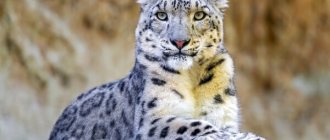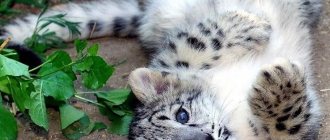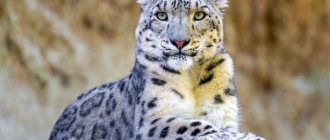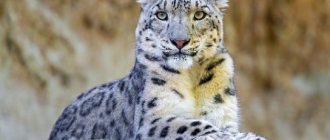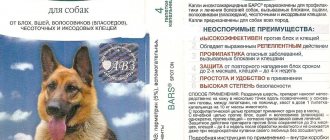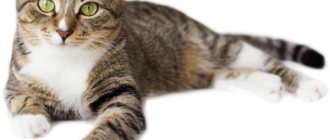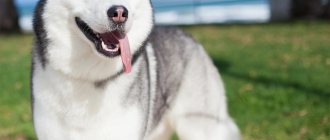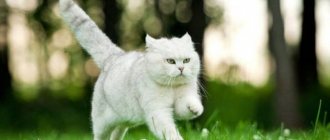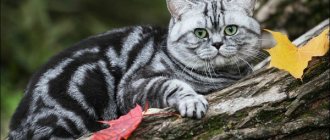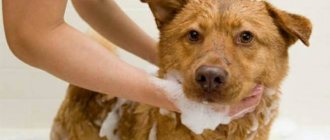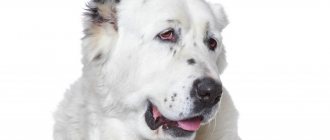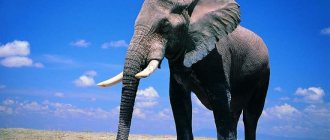- Wild animals
- >>
- Mammals
The snow leopard is an amazing inhabitant of the mountains, a predatory, dexterous, and very graceful animal.
The animal is not called snow for nothing. This is the only representative of the cat family that lives in the mountains, where there is snow all year round. The predator is also called the snow leopard, the lord of the mountains or the snow leopard. In ancient times, due to the similarity of appearance, they were called snow leopards, and were even considered representatives of the same species. However, snow leopards are not related to leopards. They are much stronger and faster, although they are inferior in size. Unfortunately, today this incredibly beautiful predator is on the verge of complete extinction.
Description
This predatory animal lives in the mountains and belongs to the cat family. In the 17th century, people often confused them with leopards, but later they were classified as a separate species. The first scientific description of the snow leopard was compiled in 1775 by naturalist Johann Schreber.
Snow leopards are easy to distinguish from other cats due to their short legs and light color. Also, most of them look quite massive, as if they are overweight, but this is a deceptive misconception that appears due to the large amount of fur.
Origin story
Centuries passed, millennia changed, and dogs changed with them, mutating, crossing with others, but preserving that very original ancient gene. Today, a number of breeds boast similarities to their Ice Age ancestors, and one of them is the Beauceron French Shorthair Shepherd.
The first mentions of black and tan herding dogs date back to the 16th century - these direct descendants of wolves herded flocks of sheep not only in the French province of Beauce, from which they got their name, but throughout the country. However, in those days there were no exterior criteria, and the main thing for a dog was its working qualities, but one way or another, certain characteristics were assigned to the dogs, and in the 19th century the Beauceron breed was officially recognized.
Origin of the species
It was initially believed that the first ancestors of the snow leopard appeared during the Pleistocene era, which ended 11.7 thousand years ago. However, remains were later found that were between 1.2 and 1.4 million years old. This suggests that predators appeared on the planet much earlier.
The ancestors of cheetahs appeared approximately 1.5 billion years ago.
Scientists are still arguing about which family snow leopards belong to.
At the moment, they are classified in the genus Uncia, which designates animals that have characteristics of large and small cats at the same time. For example, the skull structure of a snow leopard resembles that of a regular cat, but has a hyoid bone, which is characteristic of panthers. Interesting fact : now only snow leopards belong to the genus Uncia, since they are the only creature that has the characteristics of medium-sized cats.
Moreover, this classification was invented specifically for them. Since the snow leopard resembles a leopard in appearance, they have long been considered relatives. But detailed studies have proven that they have no family ties. But the snow leopard has a clear relationship with all types of panthers. It was later proven that snow leopards appeared approximately 1.67 million years ago and descended from the ancestors of today's tigers.
Some scientists have proposed dividing Uncia into subspecies, since the predator has a wide habitat. But more detailed studies have shown that at the genetic level, two snow leopards living in different places are no different and are representatives of the same species.
Offspring
Before buying a puppy, look at the parents, or better yet, ask to look at the documents confirming the purebred. The breeder is required to confirm a five-generation pedigree.
When choosing a dog, you need to pay attention to its behavior. The puppy should not be restless or overly happy when meeting a stranger. It is ideal when the puppy is curious, but with slight mistrust or even aggression.
With the right training method, the dog will become a devoted defender of its owner and his property. At the same time, the dog will be friendly and loving.
Puppy cost
On average, a Beauceron puppy costs from 50 to 100 thousand rubles.
Mating
French Smooth-haired Shepherds are a rare breed. To find a pair, contact a breed club or professional breeders. Before mating, dogs need to be prepared:
Treat for parasites, since you cannot give anthelmintics during pregnancy.
Examine for the presence of diseases; if one of the dogs has inflammatory processes, a low or high temperature, or more serious diseases, then the mating is postponed.
Beaucerons are bred at the age of 2 years ; early mating will jeopardize the health of the offspring. The bitch is bred for her 3rd heat. The interval between births is at least 1.5 years.
Appearance
Snow leopard
Externally, snow leopards are very similar to leopards, but not as large. Their legs are short, which is why their body is close to the ground. Snow leopards boast a very long, black-tipped tail. In some individuals it makes up 75% of the body length. Together with the tail, the body length of the snow leopard can reach up to 2.5 meters.
The animal reaches a height of up to 60 cm, males weigh up to 55 kg, and females only up to 40. Short limbs are covered with a thick layer of fur and are equipped with powerful muscles that allow them to climb mountains. The claws are completely hidden in the paws and are released only when necessary.
Interesting fact : the fur of a snow leopard is similar in thickness to the fur of ordinary domestic cats. But since it is very thick, it allows them to live comfortably in cold climates.
Snow leopard with a yellowish color
The head of the snow leopard is small relative to the body, the ears are located on the sides of the eyes and do not contain tassels. There are large black spots on the back that resemble stripes. They gradually go into the tail, forming incomplete rings there. The animal's belly is often white. The smallest spots are located on the face, sometimes even resembling dots.
In summer, the snow leopard's fur has a white tint; some individuals boast a yellowish color. As winter approaches, the fur becomes fluffier to protect the owner from the harsh cold. The shade also changes, becoming gray. This helps to better camouflage in the snow and against the background of mountains.
Interesting: Porcupine – description, species, what it eats, where it lives, photos and videos
Description of the breed
The muzzle is quite long, the look is attentive and intelligent, the back is straight, the paws are powerful, the tail is long and held down. The ears are naturally semi-dropping (the tips droop on the cartilage), but if desired, they can be cropped, making them erect, like those of a Doberman. However, if you do not subject the dog to this painful procedure, nothing bad will happen - modern standards allow undocked ears.
The coat resembles that of a Rottweiler - not the shortest, but not long either, thick and silky shiny. The color is black and tan (tan marks are red, yellow, red) or marbled and tan.
Photos
Character
Care and maintenance
Like all semi-wild dogs, the Beauceron is very unpretentious. He easily tolerates any climatic conditions, rarely gets sick and is able to run many kilometers a day. Of course, ideal for him would be life in a private house, where this Frenchman could run as much as he wanted (the main thing is not to put him on a chain!), but he would also feel quite comfortable in an apartment, provided that there are people with him to walk alot.
You need to be in constant contact with the Beauceron - talk, communicate, and even take part in household chores. It is in such conditions that the puppy will not grow into an aggressor, but into a true loving family friend.
Education and training
The Beauceron is a breed that requires mandatory education, and it needs to start from early childhood. The sooner you start working with your puppy, the better. This is an incredibly smart dog, so start teaching him commands and discipline from the first minutes of your acquaintance. Be prepared for the fact that by 4 months the teenager will begin to look for his place in the pack and may stop obeying and begin to insist on his own - this is a transitional age. It is during this period that it is very important to show the puppy that you are the main one in your pack, and not he. Redirect him, but under no circumstances resort to violence if you do not want an uncontrollable aggressor to grow up in your home. Remember that a dog is always angry because of fear and uncertainty. A little life hack: if your dog does not want to obey, no matter what you do, do not rush to give up or - even worse - resort to violence. Make it easy: bite your puppy on the nose. Yes, yes, just bite. Not too hard, but sensitive - it is important that he sees and feels your teeth. This is what a potential leader of a wolf pack would do. Seeing that you are able to show your teeth, the puppy will immediately recognize you as the leader.
If you become the happy owner of a small Beauceron, do not neglect early socialization. Give him the opportunity to communicate with people and other animals, let children pet the puppy and feed him from your hands. And then you will have a completely adequate and friendly dog - no matter what numerous reference books say about this breed.
Health and illness
Like all heirs of wild dogs, Beaucerons rarely get sick. They are extremely hardy and unpretentious, so they can live in the yard without fear of hypothermia or overheating. Of course, some diseases may also occur in them, for example, hip dysplasia or allergies, but this is purely individual and is not a breed trait.
However, this does not mean that annual vaccination and parasite prevention can be neglected, because Beaucerons leading an active lifestyle can easily catch ticks or fleas both in summer and winter.
Behavior and lifestyle
Snow leopards love order and consistency. Adult individuals lead an independent lifestyle, each living in their own territory with marked boundaries. As a lair, they use caves in the mountains or large stone overhangs, under which there is always shade.
The snow leopard does not like to move to new places
Snow leopards prefer to go in search of food in the early morning or evening. During the day they rest and gain strength. Interestingly, each snow leopard has a clear route that it constantly follows when walking around the territory. This is partly due to the fact that the lands are covered with a thick layer of snow, and each time it is quite problematic to re-pave your way. Therefore, snow leopards prefer to follow a well-trodden route.
The predator does not like to move to new territory, so it will patrol its territory until the last moment, until some factors literally force it out of there.
How long does a snow leopard live?
The average lifespan of a snow leopard in the wild is 13 years . If the animal lives under the close supervision of a person in favorable conditions, it may well live up to 20 years. The record holder for longevity is a female who lived for 28 years.
This difference in lifespan is due to the fact that in the wild, snow leopards face many difficulties every day, such as harsh weather conditions, food shortages, etc. Also, in captivity, their body is not subjected to high physical stress. They do not need to climb rocks and get food.
Basic moments
- The Beauceron or French Shepherd is a fairly rare breed in our country.
- The animal is large, well-balanced, athletic, agile, fast and hardy.
- Historically, the Beauceron has been distrustful of strangers. To avoid problems in the future, you need to raise your dog correctly from childhood.
- The character of the French Shepherd can even be called tough. Dogs of this breed (usually males) are prone to dominance. Finding a common language with your pet and achieving mutual understanding will require a lot of time and effort.
- City residents need to know that the Beauceron is not a very suitable dog for apartment living. The reason for this is the dog’s active temperament and the need for constant physical activity.
- The Beauceron is distinguished by a slow maturation process - until two or three years of age, the dog is not considered an adult.
- Middle-aged and older children should immediately be explained the basic rules of behavior with such an animal. The Beauceron will not tolerate pranks for a long time, but if the norms of friendly communication are observed, it is quite capable of becoming a devoted friend and protector for the child. If there are very young children in the house, the dog will immediately take custody of the smallest members of the “pack”. Beaucerons are excellent nannies.
- It is necessary to train a French Shepherd. The Beauceron was created for service and work, and depriving a dog of its true purpose is simply not humane.
The Beauceron is an indigenous breed, a direct descendant of the wolf. Originally an irreplaceable herding dog, today it is rightfully considered a first-class watchdog and a full-fledged family member who has earned the absolute trust of a person. Beaucerons embody the best traits of the canine family: strength, endurance, endless devotion, ability to be companions and a willingness to protect those they love.
Range – where does the snow leopard live?
Habitat of the snow leopard
Since each individual has its own territory from 15 to 200 km, into which other brothers are prohibited from entering, even with a small number, their habitat is quite large.
Snow leopards choose steep mountains as their place of residence, preferring to settle at an altitude of 1500 to 6000 meters above sea level. Depending on the surrounding conditions, the animal can descend into forest areas in search of food or climb to the very tops of rocks.
Now snow leopards are found mainly in Mongolia, Kazakhstan, Afghanistan, Russia, India, China, Tajikistan and Uzbekistan. They can be found in mountainous areas with little snow cover and extensive bushes.
Interesting fact : only 2% of the total number of snow leopards live in Russia.
Nutrition
The snow leopard sneaks up on its prey.
The snow leopard's diet consists mainly of meat, but in times of famine it does not hesitate to eat berries and some types of plants. He gives his main preference to large ungulates: yaks, rams, mountain goats. This is due to the fact that to be completely satiated, a predator needs to eat at least 3 kg of meat. If he does not come across worthy prey for a long time, he may switch to birds and rodents. There have been cases where snow leopards have descended from the mountains to nearby farms and feasted on livestock.
Snow leopards prefer to hunt near bodies of water, guarding animals that come to drink. He hides in the bushes or snow, merging with the terrain, after which he imperceptibly reduces the distance to several tens of meters and begins to take off. Having reduced the distance to a minimum, the animal jumps on the back of the prey and bites its neck.
The snow leopard takes the food obtained during the hunt to its den. The predator never starts eating right on the spot, preferring to feast on it in a calm environment. Interestingly, he doesn't mind sharing food with others. Having eaten, the snow leopard can leave uneaten meat for birds and predators.
Reproduction and offspring
The breeding season for snow leopards is in the spring. While patrolling his domain, the male begins to make special sounds, similar to a rude meow. Having heard them, the female living in the neighboring territory reciprocates, after which the pair meets on her territory. After this, the male returns to his place and no longer sees the female.
Interesting: Why do animals have fluffy tails? Photo and video
Female with kittens
The gestation period lasts 3-4 months depending on environmental conditions. An average of three kittens are born at one time. Their length is approximately 30 cm, their weight is 0.5 kg, the fur is brown and thick, strewn with spots all over the body. During the first week, the cubs are blind and lie near their mother all the time, feeding on milk. When they open their eyes, they begin to learn to walk. For the first few months, kittens do not leave the den and feed only on milk.
Later, they begin to go hunting with their mother and learn to get food. The kittens watch the female stalk her prey, and then try to repeat it. By the age of three, an adult is able to take care of itself independently. Then she leaves her mother’s den and goes in search of a future home.
Social structure and reproduction
Photo: Snow leopard cub
Animals tend to lead a solitary lifestyle. Individuals of the opposite sex communicate with each other only during marriage. Females mate once every two years. Animals are naturally monogamous. When existing in captivity or in national parks and protected areas, they can be monogamous.
The period of marriage depends greatly on the time of year. It begins with the onset of winter and lasts until mid-spring. Females attract males by making a long, creaking sound. Males respond to the call. When individuals of different sexes are found in the same territory, they themselves behave more actively. She raises her tail like a pipe and walks around the male. During the mating process, the male holds the female in one position by grabbing the fur near the withers with his teeth. The female's pregnancy lasts 95-115 days. From mid-spring to mid-summer, small kittens appear. Most often, one female is able to reproduce no more than three kittens. In exceptional cases, five kittens may be born. The female leaves to give birth to her babies in the stone gorges.
Interesting fact. The female makes a kind of hole in the gorge, lining its bottom with fur from her belly.
The weight of each newborn kitten is 250-550 grams. Babies are born blind; after 7-10 days their eyes open. They leave the lair after two months. Upon reaching 4-5 months of age, they participate in hunting. Until six months, the mother feeds her babies with breast milk. Upon reaching the age of two months, kittens begin to gradually become familiar with solid, meat foods. Females reach sexual maturity at the age of three years, males at the age of four years. During the first year they maintain the closest possible connection with their mother.
The average lifespan of predators is 13-15 years in natural conditions. In captivity, life expectancy can increase to 27 years.
Natural enemies
The snow leopard has no natural enemies, since it lives high in the mountains, where other predators do not live. The only living creatures that, in theory, can fight back are large artiodactyls, which also live in these territories. But the herbivore would rather try to run away when it sees a snow leopard than to engage in battle with it.
Due to their lifestyle, snow leopards are at the top of the food chain. True, this does not protect them from humans, who often try to catch this or that individual.
Population and species status
The snow leopard is on the verge of extinction as a species. Currently, several thousand individuals are under close care in zoos. It is difficult to say how long they live in nature, because... Snow leopards specifically choose places that are difficult for humans to reach for safety reasons. It is estimated that between 3,500 and 7,000 individuals live in the wild.
Snow leopards prefer to live high in the mountains
Interesting fact : in 1984, the snow leopard was officially listed in the Red Book; in most countries it is regarded as an animal on the verge of extinction.
The gradual disappearance of snow leopards, unfortunately, is directly related to humans. Despite the fact that hunting these predators is prohibited in any state, poachers are not afraid to break the law for the sake of valuable fur.
About dog breeds No. 137. Spanish Alano; Basque Dogo
1. Spanish Alano.
The history of the ancient Spanish Alans is closely connected with the nomadic tribe of Alans, of Scythian-Sarmatian origin. When the Huns moved to Europe in the 5th century AD, part of this people followed them. Large mastiff dogs accompanied nomadic tribes, performing the role of universal hunters, guards and shepherds. As they moved, the dogs accompanying the tribes became crossbred with the dogs of local groups. Subsequently, the resulting breed group spread throughout the Iberian Peninsula, giving rise to many modern Great Dane and Molosser dog breeds. In addition, with the Spanish conquistadors, the Alanos also came to other parts of the world, including Latin America, where their direct descendants were bred: the Uruguayan Cimarron, the Fila Brasileiro, and the Dogo Argentino.
The Alano, later known as the Spanish Bulldog, was used primarily as a guard dog, cattle herding dog, wild boar hunter, and as a war dog in the army, where the Alano was used until the 19th century. And of course, strong and flexible bulldogs were one of the main participants in bullfights.
With the development of firearms, the use of fighting dogs becomes meaningless, and the Alanos disappear from the ranks of the Spanish army. For the same reasons, interest in traditional driven hunting with dogs also fell; for hunting with firearms, the scent and speed that the hounds had were more important than the strength for a direct fight with a boar, as the Alanos worked. In 1883, a ban was adopted on fighting between dogs and bulls, which almost completely deprived the Alano of any user application. For some time, Alanos were still used for driving livestock, but a number of regions changed the principles of farming, new breeds of cattle were imported, and with them came new breeds of dogs with a different form of working with livestock. Once the most famous breed, the pride of Spain gradually began to decline. The final extinction of the Spanish Bulldog was caused by the Civil War and the subsequent World War II.
Previously, the Alano was considered a lost breed, but now the website dedicated to the restoration of the Alano indicates that in the 80s of the 20th century, Spanish dog handlers found about 300 dogs phenotypically similar to the Alano in separate settlements of Cantabria, Castile and Leon. I cannot say whether the current Alano is a direct descendant of the legendary dogs of antiquity, or a reconstructed breed; it is only known that the blood of a German boxer has been infused into the local dogs. There is no official information about the use of any other dog breeds.
Snow leopard conservation
In nature reserves, snow leopards have more favorable conditions for creating offspring.
After being included in the Red Book, people became seriously concerned about preserving the species. Special reserves with natural habitat conditions are still being created, where animals can live and reproduce in peace.
Also, since 2000, a regulation has been passed making the sale of snow leopards or their fur illegal. Now any poacher who is caught doing this will face a very real prison sentence.
In zoos, snow leopards receive special care. Workers try to maintain favorable conditions and the desired temperature. The procedure for the appearance of offspring is also planned in advance, individuals are selected for a pair and the necessary preparations are carried out.
Modern technologies make it possible to painlessly implant chips into animals that show their location. This is especially true when you consider that the snow leopard can live alone in an area of 200 km2. And if he suddenly gets into trouble, thanks to the sensor, the search will be reduced from several days to a couple of hours. Zoologists are still developing effective ways to protect snow leopards.
Snow leopard and man
Snow leopard and man
As mentioned above, man is the only creature on Earth that snow leopards should be wary of. Even though there are people who sincerely try to protect snow leopards, there will always be those who want to harm them and make them an object of profit. Because of this, the interaction between humans and snow leopards can be very different and can be both positive and negative.
Snow leopard hunting
Before the ban on hunting snow leopards, they were tracked all over the world. Moreover, there was a stereotype that snow leopards are pests, attack livestock, people and try in every possible way to disturb other creatures. Now, when the habits of the animal are more or less studied, it is difficult to believe in this, but then there were such beliefs, so hunters freely went on campaigns to hunt this animal.
Interesting: Living and inanimate nature - what is it, definition, description and photo
Snow leopard hunting is banned worldwide
Interesting fact : in the 1950s, the skin of a snow leopard in the USSR cost approximately 3 rubles. It was used to make carpets, lips and warm clothing.
After snow leopards were recognized as an endangered species and hunting was banned, the number of pelts harvested dropped significantly. If in the 1910s 700-800 animals fell into the hands of hunters during the year, then in 1998 a total of 20 skins were obtained, and even then illegally. It is worth noting that hunting for snow leopards continues to this day, despite all the prohibitions. There is also illegal catching of animals and their sale.
Attacks on a person
Snow leopards are afraid of people and try not to make contact with them. Only two cases of attack on a person have been officially registered. In the first situation, the animal attacked two tourists who entered its territory. The predator was defeated and studied. The analysis revealed that the individual had rabies, which was the cause of the conflict.
In the second case, the beast attacked the man. After studying the carcass, it became clear that the leopard was very old and completely emaciated, since he had not eaten for several days, and there were practically no teeth in his mouth. Obviously, the beast was no longer able to obtain food for itself and saw in man the only chance of salvation. Both conflicts took place on the territory of Almaty.
Captivity
There are currently approximately 2,000 snow leopards in captivity, with 1,200 of them in China. Owners of nature reserves and zoos try to create the most favorable conditions for animals. There have even been cases where organizations refused to take in snow leopards because they doubted that they could provide them with everything they needed.
Young snow leopards getting comfortable at the zoo
In artificial conditions, snow leopards reproduce well. On average, 200 cubs are born per year. Currently, only 12% of zoo animals were brought from the wild. The rest were already born in artificial conditions. Every year, new programs are developed to improve the living conditions of snow leopards.
History of the Beauceron breed
If we talk about the origin of the Beauceron breed, today there are two main hypotheses put forward. According to one of them, the ancestor of the French smooth-haired shepherd was a fossil peat dog, the remains of which were discovered in the Jura mountain range. According to another, the ancestor of the Beauceron was a wolf. This version is supported by the great similarity of animals not only in appearance, but also at the intracellular level. Only geneticists can dot the i’s, but at the moment this problem is not being studied.
The following is known for sure: the Beauceron breed was formed on the territory of modern France practically without any outside influence. Evolutionary development led to the appearance of a fairly large, very powerful and hardy dog, which was successfully used in hunting large animals.
Over time, the development of agriculture, especially grazing livestock, led to massive deforestation and a significant decrease in the number of hunted animals - bears, wild boars and deer. Man had an urgent need for herding dogs, and at first the priority task of such animals was to protect the flock from wolves and even robbers.
The first documentary information about the French Shepherd can be found in a manuscript that dates back to 1578. Much later, in 1809, one of the Catholic abbots wrote a treatise “Work in Agriculture”, where he discussed in detail the issue of the correct use of dogs for herding sheep. The author described two types of dogs: the long-haired Brie shepherd dog and the much more powerful guard dog, which can handle a wolf alone.
Half a century later, in 1863, a dog exhibition was held in Paris, where the French Beauceron was first presented to the public. However, the breed received official recognition later, in 1896. At its meeting, a commission of authoritative experts approved the first standards for two varieties of French shepherd dogs - Berger de Brie (long-haired) and Berger de Beauce (smooth-haired). The name "Beauceron" was given by the French region of Beauce. A year later, under the auspices of the French Ministry of Agriculture, the first kennel club of this breed was created. The official club, which dealt directly with the Beaucerons, appeared in 1911. It exists to this day and strictly controls the breeding of representatives of the breed in France.
Berger de Beauce is very popular in its own country, but much less known outside its borders. Experts say this is for the better. None of the “outsiders” had a hand in the breeding work, which made it possible to fully preserve all the working qualities of the dogs to this day.
Today, the Beauceron in France is an excellent service dog, which is successfully used both in the army and in police work.
Snow leopard in heraldry
Previously, only a leopard was depicted on coats of arms, since people did not see a significant difference between the animal. But when a clear distinction was made between the species, those heraldic figures where the animal was white began to refer to the snow leopard, and where it was yellow - to the leopard.
Now the snow leopard is depicted on the coats of arms of: the city of Bishkek, the Shushensky district, the city of Samarkand, the largest city of Kazakhstan - Almaty, the Republic of Khakassia, the Republic of Tatarstan. On each coat of arms, the animal is presented with a different level of detail and depiction. For example, on the Samarkand coat of arms he even has wings.
Because snow leopards live in snowy mountains, they are more associated with winter sports, especially ice hockey. Two KHL clubs play under the symbols of the white predator: “Ak-Bars” and “Barys”.
In 2011, the snow leopard became the mascot of the Asian Winter Games, thanks to which symbols with its image were used everywhere. And in 2014, when the Olympic Games were being prepared in Sochi, the commission considered various options for mascots. Among them was an image of a white leopard, which council workers mistakenly called a leopard.
Why is the snow leopard (irbis) called that?
The snow leopard lives in the snow-capped mountains.
In the 17th century, the animal had many consonant names. Turkic hunters called it “irbish”, in Central Asia it was called “ilbers”, in the territories of Kazakhstan – “irviz”. Over time, these names merged together and turned into “irbiz,” but the ringing ending quickly gave way to a dull one. Closer to the 18th century, the animal began to be called “irbis”.
At the same time, the name “snow leopard” began to be assigned to them. Leopards were called leopards, but due to their external resemblance to snow leopards, this term gradually migrated to the latter. However, due to the peculiarities of the color, the prefix “snowy” was added.
Maintenance and care
Beauceron dogs do not require special care. They can live in apartments and houses with large garden plots. If the dog lives on the street, then it needs to equip a large enclosure. You cannot put him on a chain, because the dog can become uncontrollable and aggressive.
Beaucerons have one unpleasant feature: their fur has an unpleasant odor. To get rid of it, dogs' fur requires special care.
You need to comb it 2-3 times a month using soft brushes.
Pets need to be bathed 2 times a year.
Dogs' claws also require special attention. They are regularly shortened so that they do not interfere with the animal when walking.
The ears and eyes of the animal require regular cleaning and inspection.
Nutrition
Beauceron dogs can be fed natural food or premium dry food. If the owner chooses natural food, then the dog’s diet should include products such as:
